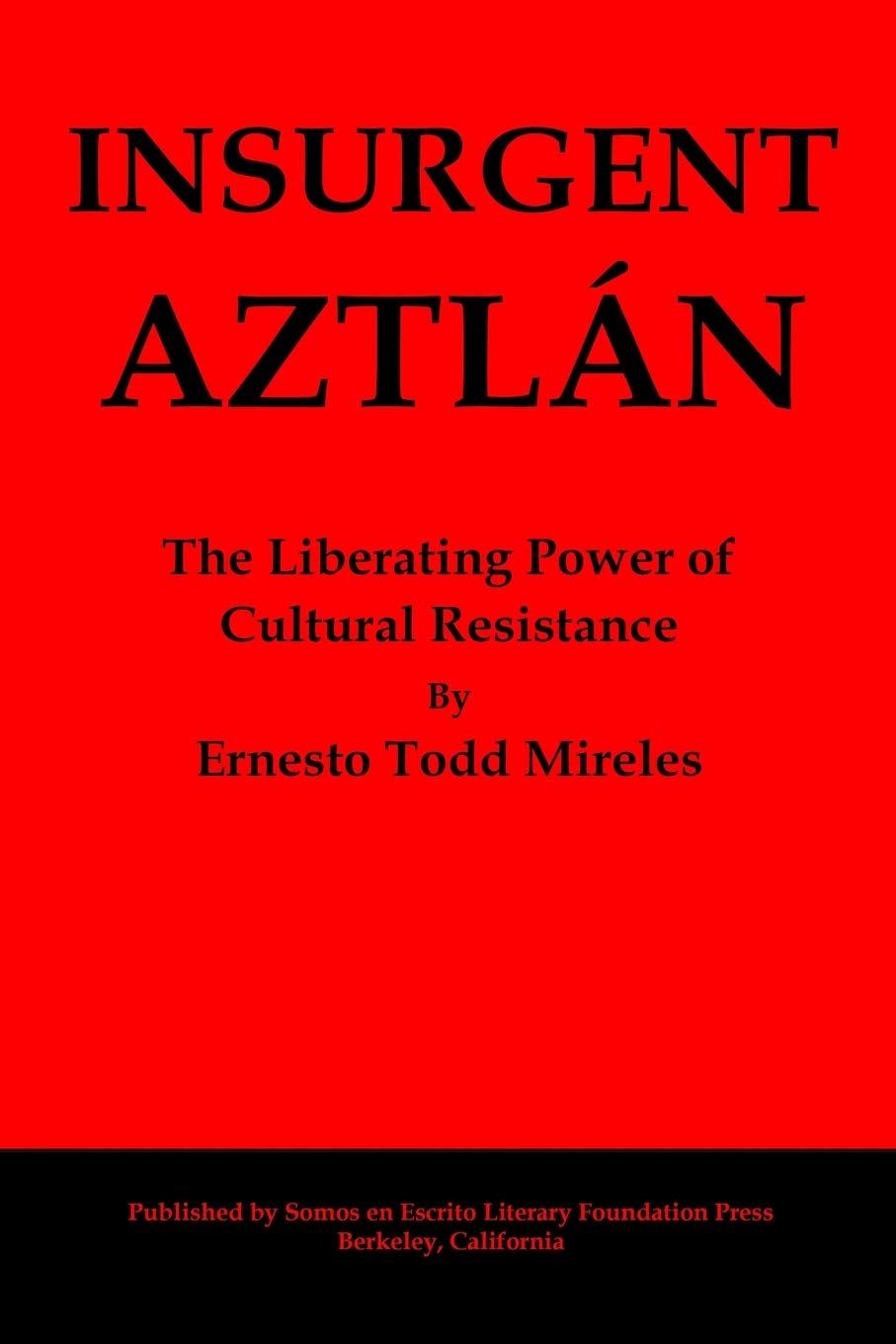Insurgent Aztlán: The Liberating Power of Cultural Resistance

This book is an expanded version of a dissertation completed in American Studies in 2014 at Michigan State University. It consists of an introduction, five chapters, a conclusion, and a bibliography and endnotes. It also includes a preface, which is really a foreword, by Armando Arias who lauds it as “an original contribution to the existing scientific knowledge” that will “spark new transformative cultural interpretations” in the pursuit of a Xicano nation.
The basic premise of the book is that Xicano nationalism can be sustained and promoted through cultural resistance, primarily through arts and literature that engender understanding of settler colonialism and ways to move beyond it to establish a Xicano nation. Contrary to what Arias states, however, there is little scientific evidence provided for the arguments presented. There are innumerable quotes and references to the works of Franz Fanon and Amilcar Cabral, but little empirical evidence provided for generalizations made throughout the book. This is a work of literary and cultural analysis.
In the introduction the author presents four periods of Xicano/a political and cultural development following the takeover of northern Mexico by the U.S. in 1848. Period One, the Mexican Period, begins in 1848 and ends in 1915 with the Plan de San Diego in South Texas. Period Two, no label provided, is from 1915 to the 1950s, when Xicano/as formed regional organizations that later would become nationwide organizations. Missing are the sociedades mutualistas in the Southwest that were formed in Period One. One of the most prominent and influential was the Alianza Hispano Americana established in Tucson, Arizona in 1894. Begun as an insurance and benefits organization, it was a precursor to LULAC and the G.I. Forum that evolved into a civil rights organization that fought against de jure segregation.
Period Three, labeled Mestizaje/Chicano Power Period, is from the 1950s to the 1980s. This period, according to the author, promoted the ideology of mestizaje and a form of “proto-nationalism” around Aztlán, the mythical homeland of the Aztecs. During this period Chicano Movement newspapers, Chicano Studies programs, and Chicano literature grew rapidly. The fourth period, the Indigenous Period, presumably from the 1980s to the present, is characterized by the “acceptance of the Xicano/a Indigenous heritage” (p. 21). The focus of the book is primarily on Periods Three and Four.
Chapter One provides an examination of insurgency literature, decolonization, national liberation, and the roles of literature and culture in these processes. Chapter Two identifies the “dominant literary tropes within Xicano/a resistance literature” (p. 25). Chapter Three discusses the criteria for determining whether or not a piece is resistance literature, reviews the ideas of different writers and thinkers on the return to history by the colonized, as well as the promotion of cultural resistance by the colonized. Chapter Four examines Xicano/a films and how they address issues of colonialism and resistance. Chapter Five provides a critique of the ideology of mestizaje and continues the analysis of films and resistance literature.
Finally, in the Conclusion, the author reveals the mistaken ideas he had about the relationships among culture, politics and resistance, which he concludes are connected rather than separate. He was mistaken in believing that one type of political or cultural production was more grounded in resistance ideology than others. The revelation being that all works on Xicano/as contribute to an anti-colonial movement, albeit in the long run.
There are several problematic issues within the perspective presented by Mireles: 1) An anti-social-science attitude; 2) an anti-ideology-of-mestizaje viewpoint, and 3) the use of binary categories. He casts anthropology as a pseudo social science that has contributed to capitalism and globalization but does not specify how that occurred. He fails to recognize the many schools of anthropology, especially those that are critical of capitalism. While much social scientific work in this country has been Eurocentric in its orientation, not all of them have been so. Scholars in the school of critical anthropology, for example, produce complex analyses of the interconnections among economic, political, and social processes.
Mireles holds that the ideology of mestizaje is rooted in a biological understanding of race that serves colonial hegemony by promoting incorporation within colonialism. He posits Xicano/as as indigenous peoples who are descendants of Meso-Americans. Indigeneity, he claims, “is a discourse of national liberation” (p. 90). While that may be true, one cannot deny the genetic and cultural blending that has occurred across the centuries among native peoples of the Americas and those of European descent. Indeed, they are likely the most numerous of peoples in the Americas. What Mireles sees are “de-indianized Indians” who must intentionally recover their cultures—that is, “re-indianization.” But is this actually possible given that culture is constantly changing? What is it that one “re-indianizes” into? Take for example the work of Manuel Quintín Lame, a member of the Páez peoples, who led a rebellion against colonial elites and mestizos in Colombia early in the 20th century. His views in Pensamientos reflect a blend of indigenous and Catholic ideas.
Finally, the use of binary categories such as colonizer/colonized and indigenous/colonizer simplifies both the complexity of the many ethnic peoples in the Americas and the challenges posed for a hemispheric indigenous movement. While Mireles is well read in Sixties revolutionary and resistant literatures, missing is an analysis of the contemporary conditions of global capitalism, the rise of a global oligarchy of transnational corporations, and the challenges they pose for nationalist movements. The works of Couze Venn and critical Latin American philosophers probably should be consulted.
